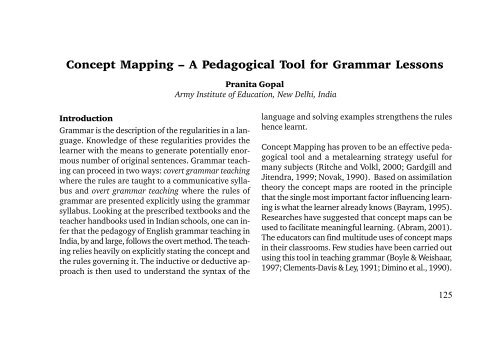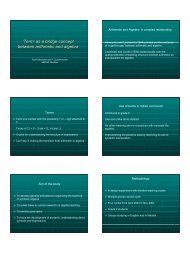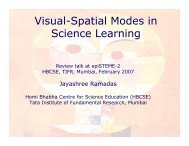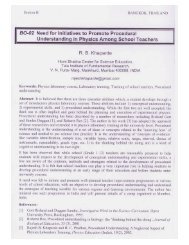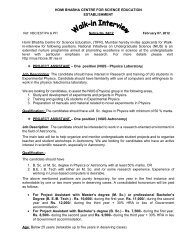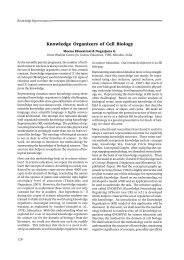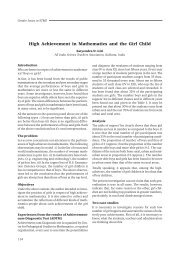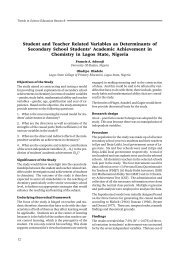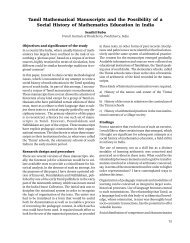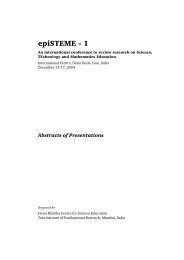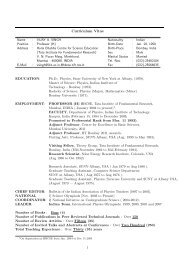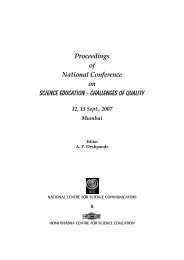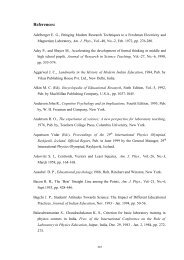Concept Mapping â A Pedagogical Tool for Grammar Lessons
Concept Mapping â A Pedagogical Tool for Grammar Lessons
Concept Mapping â A Pedagogical Tool for Grammar Lessons
You also want an ePaper? Increase the reach of your titles
YUMPU automatically turns print PDFs into web optimized ePapers that Google loves.
<strong>Concept</strong> <strong>Mapping</strong> – A <strong>Pedagogical</strong> <strong>Tool</strong> <strong>for</strong> <strong>Grammar</strong> <strong>Lessons</strong><br />
Pranita Gopal<br />
Army Institute of Education, New Delhi, India<br />
Introduction<br />
<strong>Grammar</strong> is the description of the regularities in a language.<br />
Knowledge of these regularities provides the<br />
learner with the means to generate potentially enormous<br />
number of original sentences. <strong>Grammar</strong> teaching<br />
can proceed in two ways: covert grammar teaching<br />
where the rules are taught to a communicative syllabus<br />
and overt grammar teaching where the rules of<br />
grammar are presented explicitly using the grammar<br />
syllabus. Looking at the prescribed textbooks and the<br />
teacher handbooks used in Indian schools, one can infer<br />
that the pedagogy of English grammar teaching in<br />
India, by and large, follows the overt method. The teaching<br />
relies heavily on explicitly stating the concept and<br />
the rules governing it. The inductive or deductive approach<br />
is then used to understand the syntax of the<br />
language and solving examples strengthens the rules<br />
hence learnt.<br />
<strong>Concept</strong> <strong>Mapping</strong> has proven to be an effective pedagogical<br />
tool and a metalearning strategy useful <strong>for</strong><br />
many subjects (Ritche and Volkl, 2000; Gardgill and<br />
Jitendra, 1999; Novak, 1990). Based on assimilation<br />
theory the concept maps are rooted in the principle<br />
that the single most important factor influencing learning<br />
is what the learner already knows (Bayram, 1995).<br />
Researches have suggested that concept maps can be<br />
used to facilitate meaningful learning. (Abram, 2001).<br />
The educators can find multitude uses of concept maps<br />
in their classrooms. Few studies have been carried out<br />
using this tool in teaching grammar (Boyle & Weishaar,<br />
1997; Clements-Davis & Ley, 1991; Dimino et al., 1990).<br />
125
Knowledge Representation<br />
<strong>Grammar</strong> is famous <strong>for</strong> its numerous interlinked concepts.<br />
Teaching grammar with its interlinked concepts<br />
is a challenge to every language teacher. As a teacher<br />
educator, the researcher chose to study the effect of<br />
using concept maps in teaching various grammatical<br />
concepts to the learners and to see whether learning<br />
through concept maps is likely to be more effective as<br />
compared to other pedagogical options.<br />
Objective<br />
To study the effect of the use of concept maps on the<br />
teaching and learning of English grammar.<br />
Hypothesis<br />
The use of concept maps is effective in the teaching<br />
and learning of English grammar.<br />
The Plan of the Study<br />
In view of the objective it was decided to conduct the<br />
experiment on class IX students of Army Public School,<br />
Delhi Cantt. The 94 students chosen <strong>for</strong> the study belonged<br />
to the two sections of class IX. One section was<br />
chosen to be the experimental group while the other<br />
the control group. An initial test was planned and administered.<br />
This test, based on the class VIII syllabus,<br />
aimed to check whether the two groups were comparable.<br />
Keeping in mind the school schedule, it was decided<br />
that thirty teaching periods would be utilized per group<br />
to deliver the instruction. The topics chosen <strong>for</strong> the<br />
delivery of instruction covered two areas: <strong>Grammar</strong><br />
and English prose. The prose lessons were selected to<br />
study the feasibility of using concept maps in learning<br />
the English prose lessons. The classes conducted covered:<br />
Parts of Speech, Direct – Indirect, Active Passive<br />
Sentences and from their textbooks (Main Course Book,<br />
published by the NCERT, New Delhi) Amundsen’s Journey<br />
to the South Pole and Whales.<br />
In sync with the objective, in the experimental group<br />
the instruction was to be imparted using concept maps<br />
and in the control group using the lecture method. In<br />
the experimental group the concept maps on grammar<br />
lessons were to be developed in the classroom using<br />
the student’s pervious knowledge while in the prose<br />
lessons, as the prose proceeded.<br />
The classes to be conducted with the experimental<br />
group and control group were to use only the prescribed<br />
textbooks and the available resources: blackboard and<br />
coloured chalks.<br />
It was planned that after thirty lessons another test was<br />
conducted on the topics covered in the class. It was<br />
also planned the types of questions in the test did not<br />
favour any one methodology.<br />
Delimitation<br />
This being a preliminary study (to be followed up subsequently)<br />
a single school was chosen and only selected<br />
portions of the prescribed syllabus were covered during<br />
the study.<br />
Analysis and Interpretation<br />
Table 1 shows the mean and standard deviation of the<br />
two groups on the test conducted on class VIII syllabus.<br />
The means, standard deviation and the spread of scores<br />
around the mean shows that two groups were comparable<br />
on the test taken be<strong>for</strong>e the study began.<br />
Once it was established that two groups were comparable,<br />
the delivery of instruction took place in the respective<br />
methodology. On covering the decided topics<br />
126
Knowledge Representation<br />
another test was conducted on the same groups.<br />
Table 2 shows that the mean score of the experimental<br />
group is higher than the control group showing thereby<br />
achievement is better.<br />
The t test conducted separately on the experimental<br />
and control group scores on Test1 and Test 2, shows<br />
that the improvement in achievement in the experimental<br />
group is significant at 0.01 level whereas the t<br />
test does not show the same <strong>for</strong> control group.<br />
Conclusion<br />
Students who are imparted learning experiences<br />
through concept map signal a better per<strong>for</strong>mance on<br />
their understanding of the concepts of English grammar<br />
as compared to the ones taught through commonly<br />
prevalent options.<br />
Special Education, 33 (1), 2-17.<br />
Novak, J. (1998). Learning, Creating, and Using Knowledge,<br />
Erlbaum, Lawrence Associates, Inc.<br />
Novak, J. D. (1990). <strong>Concept</strong> maps and Vee diagrams:<br />
two metacognitive tools to facilitate meaningful learning.<br />
Instructional Science, 19(1), 29-52.<br />
Novak, J., Gowin B.(1984) Learning How to Learn,<br />
Cambridge University Press<br />
Ritchie, D., & Volkl, C. (2000). Effectiveness of two<br />
generative learning strategies in the science classroom.<br />
School Science and Mathematics, 100(2), 83-89. Special<br />
Education, 33(1), 2-17.<br />
References<br />
Abrams, Robert, Meaningful Learning: A Collaborative<br />
Literature Review of <strong>Concept</strong> <strong>Mapping</strong>, http://<br />
www2.ucsc.edu/mlrg/clr-conceptmapping. html, pg 4.<br />
Bayram, S. (1995) The Effectiveness of <strong>Concept</strong> and<br />
Software <strong>Mapping</strong> <strong>for</strong> Representing Student Data and<br />
Process Schema in Science. (thesis)<br />
Boyle, J. R., & Weishaar, M. (1997). The effects of<br />
expert-generated versus student- generated cognitive organizers<br />
on the reading comprehension of students with<br />
learning disabilities. Learning Disabilities Research &<br />
Practice, 12(4), 228-235.<br />
Clements-Davis, G. L., & Ley, T. C. (1991). Thematic<br />
preorganizers and the reading comprehension of tenthgrade<br />
world literature students. Reading Research &<br />
Instruction, 31(1), 43-53.<br />
Dimino, J., Gersten, R., Carnine, D., & Blake, G.<br />
(1990). Story grammar: An approach <strong>for</strong> promoting<br />
at-risk secondary students’ comprehension of literature.<br />
The Elementary School Journal, 91(1), 19-32.<br />
Gardill, M. C., & Jitendra, A. K. (1999). Advanced story<br />
map instruction: Effects on the reading comprehension<br />
of students with learning disabilties. The Journal of<br />
127


